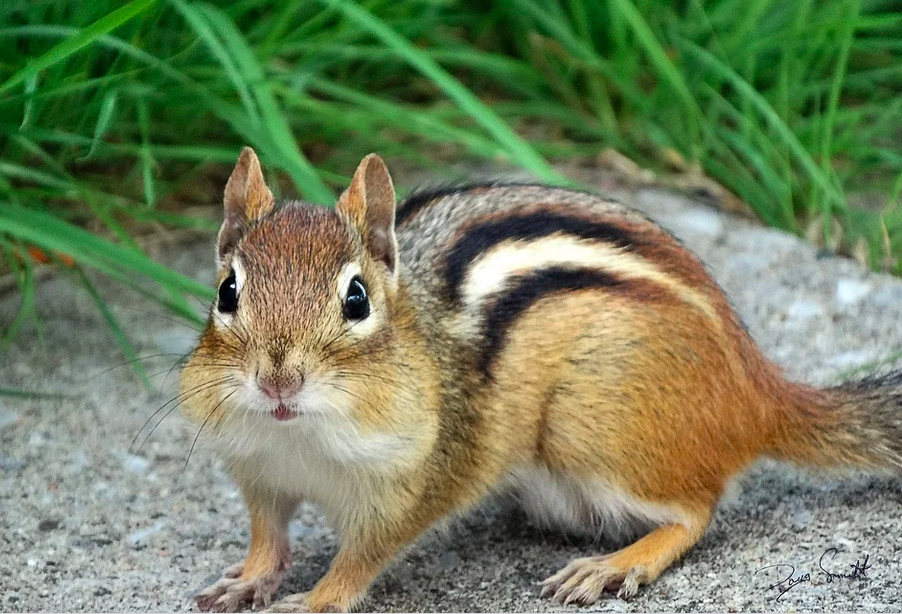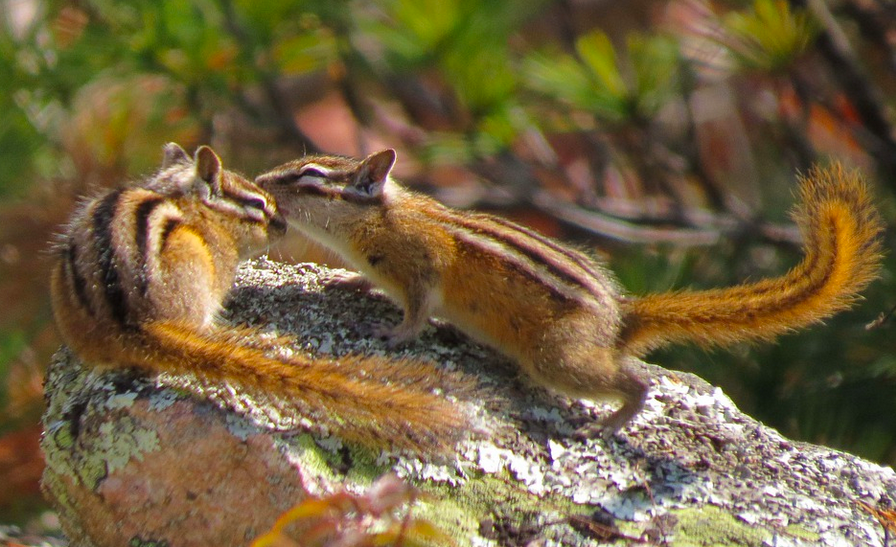Almanac: A Furry Friend

Eastern chipmunk, Tamias striatus. Photo: Pixabay.com. Public domain.
I dragged a chair to the south side of my house recently, the better to soak up waning, post-equinox sunshine on my lunch breaks. I do not normally look at this side of my property, so I was amused when, out of what I thought was solid lawn, a small, furry head with bright black eyes appeared, like a miniature gopher. It remained motionless, half in, half out of its narrow little hole. We eyed each other for what seemed like minutes, but which was probably only 30 seconds or so. Finally I took a bite, and the motion spurred the chipmunk to action. With a squeak, it exited, did a fast pirouette, then dashed back down the hole.
Other days I’ve watched as the chipmunk goes about its business of gathering seeds into its pouch-like cheeks and then hurrying down into other holes that I would never have noticed if I hadn’t seen its comings and goings. I’ve found four such entrances, and all, I’m sure, lead down into a single underground home. These homes can be quite elaborate, with little side rooms for seed and nut storage, a bedroom, a nursery (if it’s a female), and, on a lower level, a toilet.
Unlike squirrels, which remain relatively active through the winter except during storms or periods of intense cold, chipmunks pass the winter in alternating states of hibernation and wakefulness. Sometime soon my little chipmunk friend will finish stocking up on food. Then it will seal off the entrances to its home, curl into a tight little ball, and go into a deep sleep with greatly-reduced heart rate, respiration, and metabolism.
Chipmunks cannot sleep the entire winter because they can’t put on the layers of fat that would allow them to survive that long. Instead, they typically sleep for two to three weeks, wake up to eat some cached food, then go back to sleep again. Interestingly, chipmunks also sleep for up to a month in the summer to escape the hot, energy-draining days of August. Such summertime hibernation is called estivation.
I can’t tell if the little fellow I’ve been observing is male or female—like squirrels, the sexes look identical. But I’m fairly certain I was seeing the same chipmunk over and over rather than several. Chipmunks are solitary creatures, making and inhabiting an exclusive burrow system that both sexes will defend aggressively. The only time more than a single chipmunk will live in a burrow is after young are born in the early summer. Once they’re a couple of months old, however, the teenagers leave the burrow to find their own territory, which is typically quite small. Chipmunks spend their entire lives in an area usually less than a half-acre in size. Travel of 75 yards or greater from the den is unusual. The outer fringes of individual home ranges often overlap with other chipmunks.
I’ve never seen baby chipmunks around my yard, nor have I witnessed what are reported to be rather amusing behaviors of males and females during mating season, so I’m tempted to think my furry lunchtime companion is male. Female chipmunks in estrus will attract all the males in the vicinity, which will pursue her competitively. Females typically play very hard to get, and will dash in and out of small cervices or other tight quarters to escape from amorous males. One observer in the Adirondacks witnessed a female pull off a neat little maneuver: she was being chased by several males when she stopped abruptly in leaf litter, the males zooming past her in their excitement. The female then turned around and dashed to a hiding spot.
When a female decides (how, one wonders?) that a male is a suitable mate, she will allow him to approach and sniff/lick her. She then turns around to investigate the male and the two may engage in mutual contact of the nose and mouth regions…a behavior aptly, and simply, described in the literature as kissing.

Copulation is a very rapid—less than a minute—and, afterwards, the pair typically sits next to each other to groom themselves for a little while. But very soon the female chases her consort away and continues with her solitary life (until the babies are born, of course). Chipmunks are said to live between 2 and 4 years. I have not read that burrows left behind by expired chipmunks are taken over by young ‘uns, but it would certainly make sense. I rather hope that’s the case and that I have one of these perky little mammals for lunchtime company for years to come.
Almanac is a regular Indy column of observations, musings, and occasional harangues related to the woods, waters, mountains, and skies of the Pioneer Valley. Please feel free to comment on posts and add your own experiences or observations.

I put out the capsaicin-laced seed so the birds will have a shot at the feed rather than having squirrels consume everything. It works pretty well- the squirrels usually eventually stop coming around. My chipmunk population is another matter, however; they hoover the seed without any hesitation. Apparently their tastebuds are immune to the pepper’s sting!
Normally my local chipmunks are all underground by the end of October. One, however, is still actively collecting food (including some peanuts I have donated) no doubt due to the unusually warm weather. They will resurface on warm days in winter and I’ve noticed that they emerge more decisively right on the spring equinox – and this was also reported by a friend living a few miles from me – which suggests a strong response to photoperiod.
Interesting! To Tom’s observation, it’s interesting that the birds, as well as the chipmunks, are oblivious to capsaicin…I haven’t looked into the biology of sensitivity to hot peppers, but maybe I will. It’s a curious thing that topical capsaicin can actually relieve neuropathic pain. Bruce’s observation is also interesting–clearly chipmunks are responding to something, but I can’t see how sunlight would reach them in their burrows (and closed eyelids). Hmmm…doesn’t seem likely that temperature would fluctuate that much either. Fodder for more research. Thanks to you both for the comments!
Thanks, Steve.
Now I love chipmunks even more!
Stunning photos ❤️